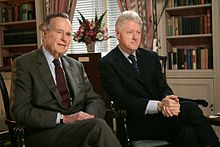- Bush-Clinton era
-
The Bush-Clinton era, alternatively described as the Clinton-Bush era, is a term used by some political journalists and commentators to describe the period in United States federal and presidential political history from 1988 (or 1980) to 2009.
Contents
Definition
The Bush-Clinton era covers the Presidencies of Ronald Reagan, George H. W. Bush, Bill Clinton, and George W. Bush. The Bush-Clinton era began during George H. W. Bush's election in 1980 as Vice President of the United States. It continued in 1988 with his election as President and his candidacy for the office in 1992. The Bush-Clinton era further exapnded with Bill Clinton's and George W. Bush's two terms each from 1993 to 2009. The term is frequently used to discuss the interconnected dynastic success of these two families over the course of almost thirty years. From 1981 to 2009, a Bush or Clinton was President or Vice President of the United States. This period also encompasses the non-federal elections of Bill Clinton as governor of Arkansas from 1979 to 1981 and again from 1983 to 1992, Jeb Bush as governor of Florida from 1999 to 2007 and George W. Bush as governor of Texas from 1995 to 2000. The era ended in 2009 when Barack Obama become sworn in as President.
Themes
Numerous political themes run through the presidential terms. All three presidencies were marked by divided government, bitter partisanship, corruption, and political anxiety, especially with the several scandals of Bill Clinton's and George W. Bush's presidencies. All three presidents promoted an expansion in the size and scope of government and an expansive monetary policy, managed by the Federal Reserve. There were several economic bubbles during this time, most notably the dot-com bubble (1993-2000) and the housing bubble (2003-2007). All three presidents initiated military operations in Iraq aimed at limiting and ultimately removing Saddam Hussein from power, and Reagan also took a large and active role in watching over the situation in Iraq during his Presidency. Further, the re-positioning of the United States in the post Cold War era and the rise of anti-U.S. terrorism became priorities.
Family relations
George H. W. Bush and Bill Clinton, despite having been opponents in the 1992 election, have since had amicable relations. Since 2001, Clinton and Bush have become especially good friends and maintained strong teamwork and relationships. Outside politics, the two of them have worked together on a number of important issues, such as relief for victims of 2004 Indian Ocean earthquake and Hurricane Katrina, lending their combined influence to charities and awareness initiatives. They were jointly awarded the 2006 Philadelphia Liberty Medal for their work on the Bush-Clinton Katrina Fund and Bush-Clinton Tsunami Fund.[1] After his 2008 presidential run and electoral victory, current President Barack Obama has also formed close relations with these two former Presidents. The five currently living Presidents (Jimmy Carter, George H.W. Bush, Bill Clinton, George W. Bush, and Obama) all posed inside the Oval Office and had lunch together on Obama's inauguration in January 2009.
Chronology
Federal positions
- George H. W. Bush - Vice President (1981-1989), President (1989-1993)
- Bill Clinton - President (1993-2001)
- George W. Bush - President (2001-2009)
- Hillary Clinton - U.S. Senator (2001-2009), US Secretary of State (2009-
Non-federal positions
- Bill Clinton - Governor of Arkansas (1979-1981, 1983-1992)
- George W. Bush - Governor of Texas (1995-2000)
- Jeb Bush - Governor of Florida (1999-2007)
See also
- History of the United States (since 1988)
References
Categories:- Political history of the United States
Wikimedia Foundation. 2010.

